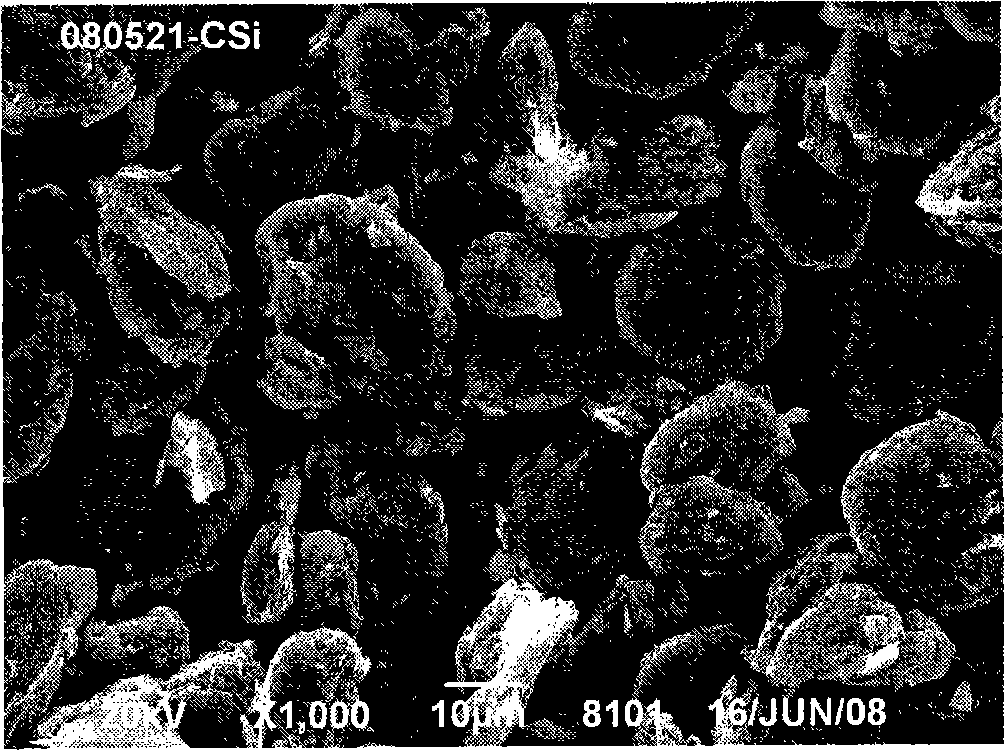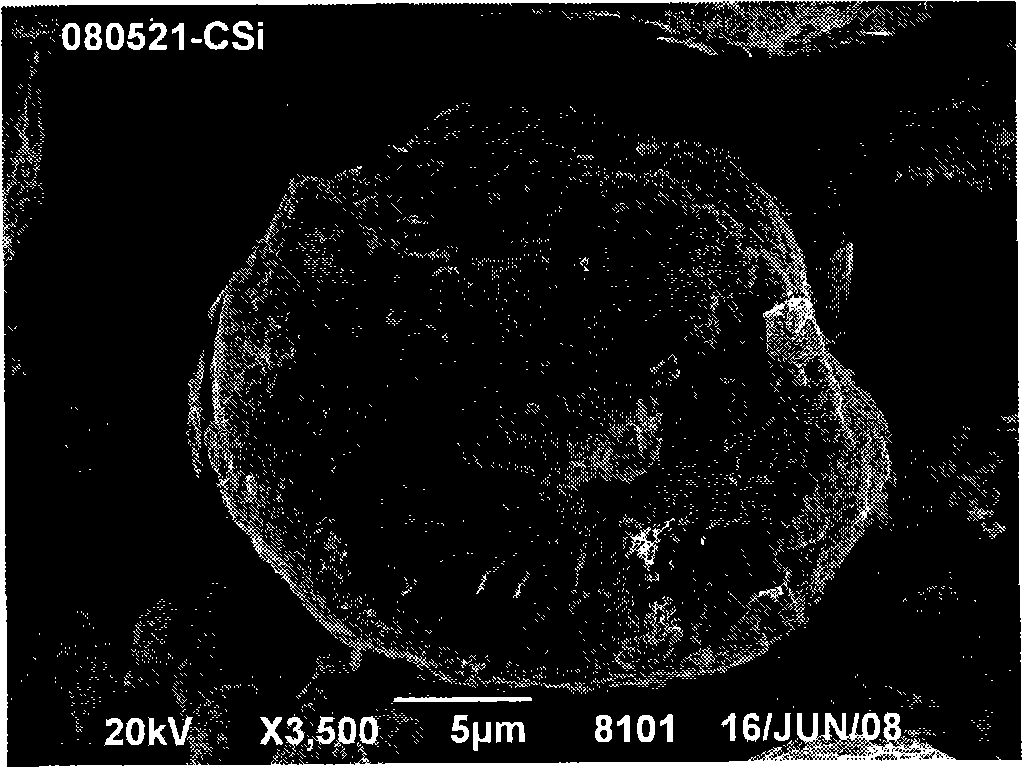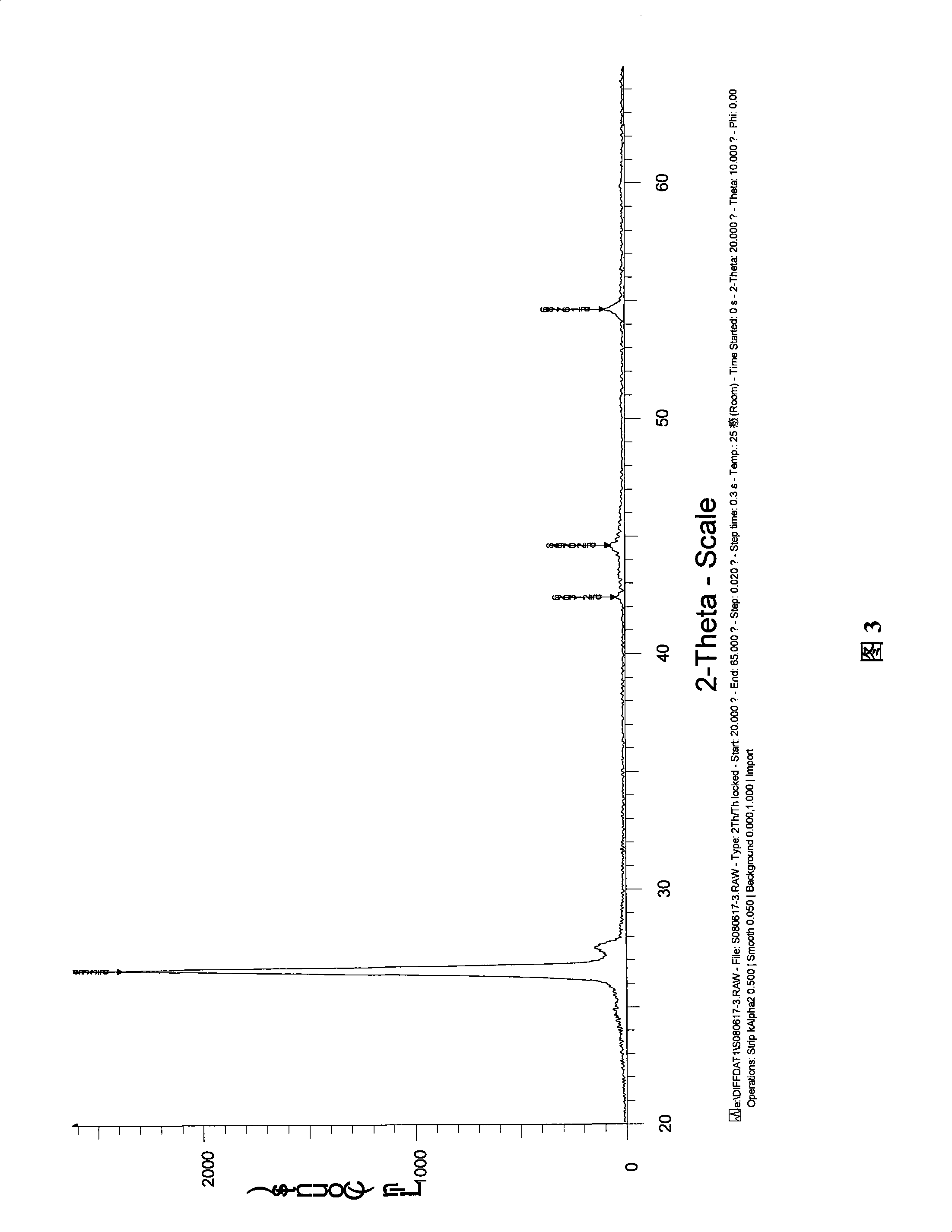Silicon-carbon composite cathode material of lithium ion battery and preparation thereof
A technology for lithium ion batteries and negative electrode materials, which is applied in electrode manufacturing, battery electrodes, chemical instruments and methods, etc., can solve problems such as improving practicality and insufficient battery performance, and achieves excellent charging and discharging performance, simple production work, and battery energy. high density effect
- Summary
- Abstract
- Description
- Claims
- Application Information
AI Technical Summary
Problems solved by technology
Method used
Image
Examples
Embodiment 1
[0029] Preparation of silicon-carbon composite anode materials with spherical coating structure
[0030] First, 100g of silicon phase particles with a particle size of 5 μm and 750g of natural graphite powder (tap density 1.00g / cm 3 , specific surface area 5.9m 2 / g, D50=19 μm, degree of graphitization 98%) mechanically high-energy ball milling in hydrogen or nitrogen atmosphere for 5 hours to obtain a composite matrix. Then get 150g redox resin and dissolve in 500g toluene, then pour the solution into a small reactor with a heating device, gradually add the prepared composite particle matrix under stirring, start heating to 80°C after stirring for 3 hours and Continue to stir, pass the volatilized toluene into the condenser to recover, and after another hour, release the material and cool it to room temperature, then press it into a block and put it into a graphite crucible in a tunnel kiln with protective gas at a heating rate of 50°C / hour Raise to 1000°C and keep it warm ...
Embodiment 2
[0038] Preparation of silicon-carbon composite anode materials with spherical coating structure
[0039] First, 100g of silicon phase particles with a particle size of 0.1 μm and 750g of natural graphite powder (tap density 1.00g / cm 3 , specific surface area 5.9m 2 / g, D50=19 μm, degree of graphitization 98%) mechanically high-energy ball milling in hydrogen or nitrogen atmosphere for 5 hours to obtain a composite matrix. Then get 150g redox resin and dissolve in 500g toluene, then pour the solution into a small reactor with a heating device, gradually add the prepared composite particle matrix under stirring, start heating to 80°C after stirring for 3 hours and Continue to stir, pass the volatilized toluene into the condenser to recover, and after another hour, release the material and cool it to room temperature, then press it into a block and put it into a graphite crucible in a tunnel kiln with protective gas at a heating rate of 50°C / hour Raise to 1000°C and keep it war...
Embodiment 3
[0043] Preparation of silicon-carbon composite anode materials with spherical coating structure
[0044] First, 50g of silicon phase particles with a particle size of 0.1 μm and 800g of natural graphite powder (tap density 1.00g / cm 3 , specific surface area 5.9m 2 / g, D50=19 μm, degree of graphitization 96%) mechanically high-energy ball milling in hydrogen or nitrogen atmosphere for 5 hours to obtain a composite matrix. Then get 150g redox resin and dissolve in 500g toluene, then pour the solution into a small reactor with a heating device, gradually add the prepared composite particle matrix under stirring, start heating to 80°C after stirring for 3 hours and Continue to stir, pass the volatilized toluene into the condenser to recover, and after another hour, release the material and cool it to room temperature, then press it into a block and put it into a graphite crucible in a tunnel kiln with protective gas at a heating rate of 50°C / hour Raise to 1000°C and keep it warm...
PUM
| Property | Measurement | Unit |
|---|---|---|
| particle size | aaaaa | aaaaa |
| particle size | aaaaa | aaaaa |
| density | aaaaa | aaaaa |
Abstract
Description
Claims
Application Information
 Login to View More
Login to View More - R&D
- Intellectual Property
- Life Sciences
- Materials
- Tech Scout
- Unparalleled Data Quality
- Higher Quality Content
- 60% Fewer Hallucinations
Browse by: Latest US Patents, China's latest patents, Technical Efficacy Thesaurus, Application Domain, Technology Topic, Popular Technical Reports.
© 2025 PatSnap. All rights reserved.Legal|Privacy policy|Modern Slavery Act Transparency Statement|Sitemap|About US| Contact US: help@patsnap.com



